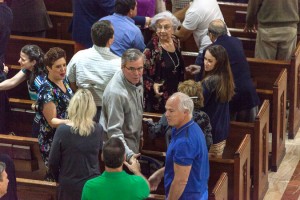Jeb Bush, 20 Years After Conversion, Is Guided by His Catholic Faith
< < Go Back
He arrived a few minutes early — no entourage, just his wife and daughter — and, sweating through a polo shirt in the hot morning sun, settled quietly into the 14th row at the Church of the Little Flower.
A bit of a murmur, and the occasional “Morning, Governor,” passed through the Spanish Renaissance-style church, with its manicured grounds and towering palms, as worshipers recognized their most famous neighbor, Jeb Bush. He held hands with the other worshipers during the Lord’s Prayer, sang along to “I Am the Bread of Life” and knelt after receiving communion.
“It gives me a serenity, and allows me to think clearer,” Mr. Bush said as he exited the tile-roof church here on a recent Sunday, exchanging greetings and, with the ease of a longtime politician, acquiescing to the occasional photo. “It’s made me a better person.”
Twenty years after Mr. Bush converted to Catholicism, the religion of his wife, following a difficult and unsuccessful political campaign that had put a strain on his marriage, his faith has become a central element of the way he shapes his life and frames his views on public policy. And now, as he explores a bid for the presidency, his religion has become a focal point of early appeals to evangelical activists, who are particularly important in a Republican primary that is often dominated by religious voters.
Many of his priorities during his two terms as governor of Florida aligned with those of the Catholic Church — including his extraordinary, and unsuccessful, effort to force a hospital to keep Terri Schiavo on life support, as well as less well-known, and also unsuccessful, efforts to appoint a guardian for the fetus of a developmentally disabled rape victim and to prevent a 13-year-old girl from having an abortion. He even, during his first year in office in 1999, signed a law creating a “Choose Life” license plate.
He differed from his church, significantly and openly, over capital punishment; the state executed 21 prisoners on his watch, the most under any Florida governor since the death penalty was reinstated in 1976. But he has won praise from Catholic officials for his welcoming tone toward immigrants and his relatively centrist positions on education — two issues in which he is at odds with the right wing of his party.
More From The Wall Street Journal (subscription required):




